Featured Articles
No Fighter Brings Out The Cookbook Analysts Like Mayweather

With the welterweight bout between title holders Floyd Mayweather 45-0 (26) and Marcos Maidana 35-3 (31) culminating this Saturday night, a lot of attention has been focused on Mayweather’s boxing style and dominance. And with that the cookbook analysts are drawing up battle plans and fight strategies; you know, the writers and analysts who basically suggest A + B = C. And when I hear those types belabor their points of what and what-nots Mayweather’s opponents must do in order to beat him, it illustrates how little they know regarding fighting applications and how they apply in actual ring combat. What they don’t understand, or in some cases refuse to, is that physicality will beat the cookbook recipe every time.
I recently read an article in the Macomb Daily in which boxing writer Marvin Goodwin stated that Maidana won’t beat Mayweather because….”He’ll follow the same pattern as Floyd’s other victims. They start the fight tentatively, star-gazing at the Mayweather aura while Mayweather dictates the pace of the fight, breaks his opponent down piece by piece and ultimately wins.” This cookbook analyst thinks that Mayweather’s opponents are “star gazing at the Mayweather aura.” The fact is, his opponents do their best work in the 1st round, as Floyd scopes them out. They become intimidated more and more as the fight goes on (the way that Canelo Alvarez did).
I’ve seen everyone of Mayweather’s fights since he’s become a superstar, beginning around 2008, which is when the Mayweather aura began to evolve into what it is today, and that’s not what I’ve seen. What I’ve seen is championship caliber fighters start the first round with a plan and thought as to what they want to do – only to find that Floyd is bigger, stronger, harder and better than what they thought. They aren’t standing there like a mummy gazing in awe. Here’s another stellar capsule of advice from Mr. Goodwin.
“Mayweather opponents, it’s time to rip that script to shreds and take a risk. The ultimate plan should be to get Mayweather out of his comfort zone. Don’t make it a boxing match, make it a fight, a knock-down, drag out, alley brawl with violent intentions, because that’s what fighting is. Don’t tiptoe around, start immediately from the opening bell and make Mayweather defend himself from a fusillade of angry punches. Make him react from a position he’s rarely faced. He’ll either back away from the surprise attack, assess the unpredictable situation and and try to regain his bearings, or he’ll stand his ground and fight. Either way, he’s out of his comfort zone, and perhaps more vulnerable to defeat.”
Yeah, like there’s a fighter around who could surprise Mayweather. The idea is idiotic, Floyd has seen it all. The above statement illustrates the cookbook perfectly. On paper, it makes perfect sense and if there’s a fighter out there fighting between 147-154 who could physically apply the above plan, he’d stand a great chance to be successful and maybe even beat Mayweather.
I love how these guys suggest, get Floyd out of his comfort zone, make it a fight and alley brawl with violent intentions because that’s what fighting is. Yes, that’s what fighting is but these geniuses must not realize that Mayweather punches back, and it doesn’t tickle. Getting busted in the face with a real sharp jab, the kind that Floyd throws, hurts, disrupts a fighter’s aggression, and blinds him for a second to the point where Floyd can send a direct right hand behind it that is going to land flush. Then he re-adjusts his body and is either in a better position to hit you again or he’s gone and the counter coming back is going to miss him. What so many guys who say Floyd can’t punch don’t realize is that he punches hard enough to keep his opponents off of him and prevents them from taking their liberties with him.
The cookbook might suggest that he’s not Thomas Hearns when it comes to punching power, but the reality of touching hands with him convinces many of the opponents who fight him that they just can’t walk through him as if he’s handcuffed. Because if they could, someone would’ve done it by now. (Jose Luis Castillo came the closest in their first fight). As I’ve often said, boxers just don’t shut it down and stop letting their hands go for no reason. The only thing that causes that, unless they’re injured, is the guy standing in front of them punching back at him.
Sure, there have been fighters of the past who could’ve gone to Mayweather and forced him to fight them off, but there’s no one fighting today between 147-154 who can do it, including Marcos Maidana. When Maidana is in the ring with Mayweather this coming Saturday night, he better have a big enough punch to make Floyd do things that he doesn’t want to in order for him to survive the fight.
Also, he must have the means to deliver that punch without getting tattooed, beaten up and peppered in the process. If he can’t execute the above he has no shot, none whatsoever, to even keep the fight close let alone score the upset. Some may suggest that if you parry Floyd’s jab and force him to his right, he’s vulnerable.
I could go on and on highlighting strategies that might get him off his game and make him more susceptible to defeat. But if the fighter following the recipe isn’t physically skilled and strong enough to execute the plan, the plan is moot and the boxing laboratory wasted a lot of time cooking it up. When in doubt refer back to the two title bouts Marvin Hagler had against Roberto Duran and Sugar Ray Leonard in 1983 and 1987. The cookbook said Hagler was least effective fighting as the attacker and was his most effective fighting as the counter-puncher as his opponents pursued him. Yet, Marvin decimated a lot of fighters as a contender and champion who tried to counter him as he was carrying the fight to them.
However, when he fought Duran and Leonard, he looked very ordinary coming forward as he was getting hit with jabs and right hands as they were moving away and kept him turning. And that happened because both Roberto and Ray were physically gifted fighters who could be effective fighting in retreat. It’s not a coincidence that they were the only two fighters who went the distance with Hagler during his seven year reign as middleweight champ.
There aren’t many things Mayweather says that I agree with. But the one thing he has said repeatedly over the last few years is “there’s no plan to beat me.” And he’s right, he’s very versatile and capable of adjusting to different tactics and strategies. The part that no one ever picks up on is, there have been fighters in the recent past who by just being who they were as a fighter would’ve either been a living nightmare for him or would’ve taken him apart. And that’s because they had the skill-set and physicality to disrupt him and force him to go places and do things in the ring that he wouldn’t want to do.
Roberto Duran: He would’ve pressured and mauled Floyd all over the ring fighting between 135-154. Duran wouldn’t have been slowed, disrupted, neutralized or bothered by Floyd’s offense or punch, he would’ve physically overwhelmed Mayweather both physically and stylistically.
Actually, his pressure and elusiveness would’ve forced Mayweather to rush his offense and made him vulnerable to Roberto’s array of hooks and right hands to the head and body. In much the same way Jose Luis Castillo did during their first bout, only ten fold.
Sugar Ray Leonard: He would’ve made one adjustment had he fought Mayweather, and he’s even stated it in the past. And that is he wouldn’t head hunt against him, he would’ve gone to the body more, and Leonard was a debilitating body puncher. Leonard had the skill, speed, punch and fighting aptitude to better Mayweather at anything he tried. Other than saying Floyd was a better defensive fighter, mainly because he’s not as offensive minded, what advantage would Mayweather have?
Leonard was faster, better offensively, punched much harder, was every bit as versatile and if toughness is a debate I’ll go with Leonard based on his level of opposition and who he defeated during his career. Leonard wouldn’t beat Mayweather because of a brilliant fight plan or strategy, he would beat him because he’s even more gifted and skilled and had the physicality to better him at every turn.
Thomas Hearns: He would’ve been Mayweather’s biggest nightmare. Hearns had such an abundance of reach and power that Floyd could’ve never countered him effectively without reaching for Thomas. Hearns could’ve stayed on the outside and pot-shotted him without ever being touched even if he missed. If a shot Oscar De La Hoya stymied Mayweather with his jab, Hearns would’ve punished him.
Against Hearns, Mayweather would’ve had to take some chances and go on the attack. However, walking into Hearns’ power would’ve been suicide for him. Mayweather wanted no part of Paul Williams and smartly retired to avoid fighting him before Williams could really make a scene challenging him. And Williams was barely a poor man’s Hearns. And just as it would be the case with Duran and Leonard, Hearns had the physicality and skill set to better Mayweather. No cookbook strategy or fight plan needed. Just being himself as a fighter would’ve got the job done. Even the three greats above couldn’t surprise Mayweather as suggested by Marvin Goodwin, they were just monsters.
When all is said and done, unless Maidana catches Mayweather on the chin with a lottery punch Saturday night, he has no chance to beat him. Mayweather has already defeated two bigger and stronger fighters (Miguel Cotto and Saul Alvarez) than Maidana in recent fights who tried to bring the heat and overwhelm him. Cotto won four rounds against Mayweather and giving Alvarez every benefit of the doubt, maybe he won one round.
No doubt Maidana will try to overwhelm Mayweather and rock him with looping left-hooks and over-hand rights like he did against Adrien Broner in his last bout. But the difference will be he’ll never get as close to him and will be peppered and tattooed much more on the way in. Once that happens and Maidana realizes that it’s not by accident, his aggression will be impeded some and then Mayweather will be in a position to do whatever he wants, whenever he wants as often as he wants and then the route will be on.
Marcos Maidana will lose to Floyd Mayweather this weekend not because he didn’t fight his fight or the right fight. No, it’ll be because he wasn’t good enough or physically strong and gifted enough to execute his perfectly laid out battle plan. Once again it will be shown for all the cookbook analyst that the plan is only as good as the fighter given the task to execute it. As Barry Tompkins once said on HBO, “I know how to dunk a basketball, but until they lower the rim, I can’t do it.”
A lot of fighters today may know the recipe as stated in the cookbook to beat Floyd Mayweather. Their only problem is they are not physically gifted enough, strong enough or skilled enough to pull it off. The only way a less talented fighter beats a superior fighter is if he gets incredibly lucky (seldom happens) or that the better fighter isn’t in shape or takes the guy lightly (those things never happen with Mayweather).
Frank Lotierzo can be contacted at GlovedFist@Gmail.com
Featured Articles
Arne’s Almanac: The First BWAA Dinner Was Quite the Shindig
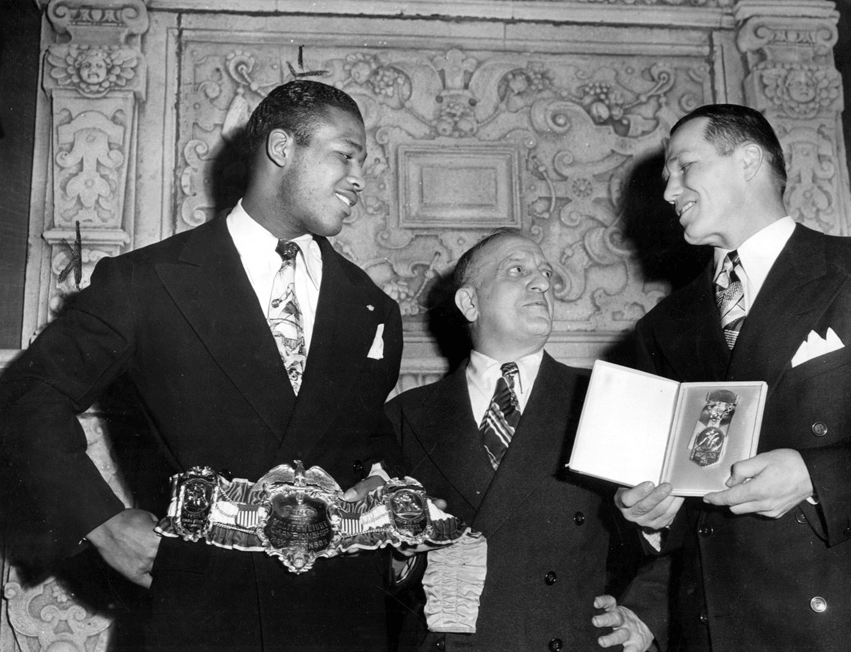
The first annual dinner of the Boxing Writers Association of America was staged on April 25, 1926 in the grand ballroom of New York’s Hotel Astor, an edifice that rivaled the original Waldorf Astoria as the swankiest hotel in the city. Back then, the organization was known as the Boxing Writers Association of Greater New York.
The ballroom was configured to hold 1200 for the banquet which was reportedly oversubscribed. Among those listed as agreeing to attend were the governors of six states (New York, New Jersey, Massachusetts, Pennsylvania, Connecticut, and Maryland) and the mayors of 10 of America’s largest cities.
In 1926, radio was in its infancy and the digital age was decades away (and inconceivable). So, every journalist who regularly covered boxing was a newspaper and/or magazine writer, editor, or cartoonist. And at this juncture in American history, there were plenty of outlets for someone who wanted to pursue a career as a sportswriter and had the requisite skills to get hired.
The following papers were represented at the inaugural boxing writers’ dinner:
New York Times
New York News
New York World
New York Sun
New York Journal
New York Post
New York Mirror
New York Telegram
New York Graphic
New York Herald Tribune
Brooklyn Eagle
Brooklyn Times
Brooklyn Standard Union
Brooklyn Citizen
Bronx Home News
This isn’t a complete list because a few of these papers, notably the New York World and the New York Journal, had strong afternoon editions that functioned as independent papers. Plus, scribes from both big national wire services (Associated Press and UPI) attended the banquet and there were undoubtedly a smattering of scribes from papers in New Jersey and Connecticut.
Back then, the event’s organizer Nat Fleischer, sports editor of the New York Telegram and the driving force behind The Ring magazine, had little choice but to limit the journalistic component of the gathering to writers in the New York metropolitan area. There wasn’t a ballroom big enough to accommodate a good-sized response if he had extended the welcome to every boxing writer in North America.
The keynote speaker at the inaugural dinner was New York’s charismatic Jazz Age mayor James J. “Jimmy” Walker, architect of the transformative Walker Law of 1920 which ushered in a new era of boxing in the Empire State with a template that would guide reformers in many other jurisdictions.
Prizefighting was then associated with hooligans. In his speech, Mayor Walker promised to rid the sport of their ilk. “Boxing, as you know, is closest to my heart,” said hizzoner. “So I tell you the police force is behind you against those who would besmirch or injure boxing. Rowdyism doesn’t belong in this town or in your game.” (In 1945, Walker would be the recipient of the Edward J. Neil Memorial Award given for meritorious service to the sport. The oldest of the BWAA awards, the previous recipients were all active or former boxers. The award, no longer issued under that title, was named for an Associated Press sportswriter and war correspondent who died from shrapnel wounds covering the Spanish Civil War.)
Another speaker was well-traveled sportswriter Wilbur Wood, then affiliated with the Brooklyn Citizen. He told the assembly that the aim of the organization was two-fold: to help defend the game against its detractors and to promote harmony among the various factions.
Of course, the 1926 dinner wouldn’t have been as well-attended without the entertainment. According to press dispatches, Broadway stars and performers from some of the city’s top nightclubs would be there to regale the attendees. Among the names bandied about were vaudeville superstars Sophie Tucker and Jimmy Durante, the latter of whom would appear with his trio, Durante, (Lou) Clayton, and (Eddie) Jackson.
There was a contraction of New York newspapers during the Great Depression. Although empirical evidence is lacking, the inaugural boxing writers dinner was likely the largest of its kind. Fifteen years later, in 1941, the event drew “more than 200” according to a news report. There was no mention of entertainment.
In 1950, for the first time, the annual dinner was opened to the public. For $25, a civilian could get a meal and mingle with some of his favorite fighters. Sugar Ray Robinson was the Edward J. Neil Award winner that year, honored for his ring exploits and for donating his purse from the Charlie Fusari fight to the Damon Runyon Cancer Fund.
There was no formal announcement when the Boxing Writers Association of Greater New York was re-christened the Boxing Writers Association of America, but by the late 1940s reporters were referencing the annual event as simply the boxing writers dinner. By then, it had become traditional to hold the annual affair in January, a practice discontinued after 1971.
The winnowing of New York’s newspaper herd plus competing banquets in other parts of the country forced Nat Fleischer’s baby to adapt. And more adaptations will be necessary in the immediate future as the future of the BWAA, as it currently exists, is threatened by new technologies. If the forthcoming BWAA dinner (April 30 at the Edison Ballroom in mid-Manhattan) were restricted to wordsmiths from the traditional print media, the gathering would be too small to cover the nut and the congregants would be drawn disproportionately from the geriatric class.
Some of those adaptations have already started. Last year, Las Vegas resident Sean Zittel, a recent UNLV graduate, had the distinction of becoming the first videographer welcomed into the BWAA. With more and more people getting their news from sound bites, rather than the written word, the videographer serves an important function.
The reporters who conducted interviews with pen and paper have gone the way of the dodo bird and that isn’t necessarily a bad thing. A taped interview for a “talkie” has more integrity than a story culled from a paper and pen interview because it is unfiltered. Many years ago, some reporters, after interviewing the great Joe Louis, put words in his mouth that made him seem like a dullard, words consistent with the Sambo stereotype. In other instances, the language of some athletes was reconstructed to the point where the reader would think the athlete had a second job as an English professor.
The content created by videographers is free from that bias. More of them will inevitably join the BWAA and similar organizations in the future.
Photo: Nat Fleischer is flanked by Sugar Ray Robinson and Tony Zale at the 1947 boxing writers dinner.
Featured Articles
Gabriela Fundora KOs Marilyn Badillo and Perez Upsets Conwell in Oceanside
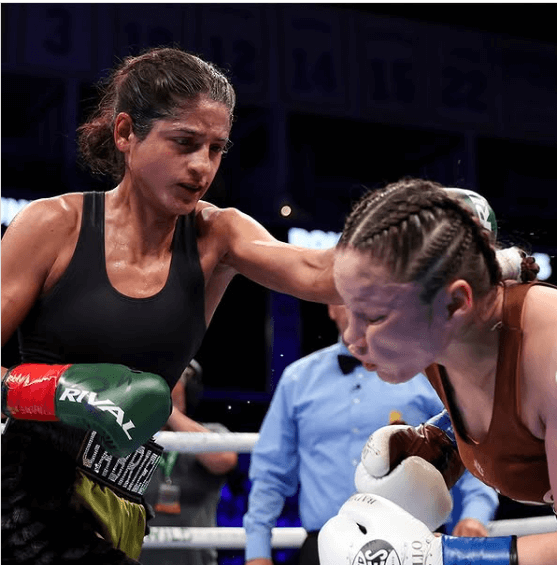
It was just a numbers game for Gabriela Fundora and despite Mexico’s Marilyn Badillo’s elusive tactics it took the champion one punch to end the fight and retain her undisputed flyweight world title by knockout on Saturday.
Will it be her last flyweight defense?
Though Fundora (16-0, 8 KOs) fired dozens of misses, a single punch found Badillo (19-1-1, 3 KOs) and ended her undefeated career and first attempt at a world title at the Frontwave Arena in Oceanside, California.
Fundora, however, proves unbeatable at flyweight.
The champion entered the arena as the headliner for the Golden Boy Promotion show and stepped through the ropes with every physical advantage possible, including power.
Mexico’s Badillo was a midget compared to Fundora but proved to be as elusive as a butterfly in a menagerie for the first six rounds. As the six-inch taller Fundora connected on one punch for every dozen thrown, that single punch was a deadly reminder.
Badillo tried ducking low and slipping to the left while countering with slashing uppercuts, she found little success. She did find the body a solid target but the blows proved to be useless. And when Badillo clinched, that proved more erroneous as Fundora belted her rapidly during the tie-ups.
“She was kind of doing her ducking thing,” said Fundora describing Badillo’s defensive tactics. “I just put the pressure on. It was just like a train. We didn’t give her that break.”
The Mexican fighter tried valiantly with various maneuvers. None proved even slightly successful. Fundora remained poised and under control as she stalked the challenger.
In the seventh round Badillo seemed to take a stand and try to slug it out with Fundora. She quickly was lit up by rapid left crosses and down she went at 1:44 of the seventh round. The Mexican fighter’s corner wisely waved off the fight and referee Rudy Barragan stopped the fight and held the dazed Badillo upright.
Once again Fundora remained champion by knockout. The only question now is will she move up to super flyweight or bantamweight to challenge the bigger girls.
Perez Beats Conwell.
Mexico’s Jorge “Chino” Perez (33-4, 26 KOs) upset Charles Conwell (21-1, 15 KOs) to win by split decision after 12 rounds in their super welterweight showdown.
It was a match that paired two hard-hitting fighters whose ledgers brimmed with knockouts, but neither was able to score a knockdown against each other.
Neither fighter moved backward. It was full steam ahead with Conwell proving successful to the body and head with left hooks and Perez connecting with rights to the head and body. It was difficult to differentiate the winner.
Though Conwell seemed to be the superior defensive fighter and more accurate, two judges preferred Perez’s busier style. They gave the fight to Perez by 115-113 scores with the dissenter favoring Conwell by the same margin.
It was Conwell’s first pro loss. Maybe it will open doors for more opportunities.
Other Bouts
Tristan Kalkreuth (15-1) managed to pass a serious heat check by unanimous decision against former contender Felix Valera (24-8) after a 10-round back-and-forth heavyweight fight.
It was very close.
Kalkreuth is one of those fighters that possess all the physical tools including youth and size but never seems to be able to show it. Once again he edged past another foe but at least this time he faced an experienced fighter in Valera.
Valera had his moments especially in the middle of the 10-round fight but slowed down during the last three rounds.
One major asset for Kalkreuth was his chin. He got caught but still motored past the clever Valera. After 10 rounds two judges saw it 99-91 and one other judge 97-93 all for Kalkreuth.
Highly-rated prospect Ruslan Abdullaev (2-0) blasted past dangerous Jino Rodrigo (13- 5-2) in an eight round super lightweight fight. He nearly stopped the very tough Rodrigo in the last two rounds and won by unanimous decision.
Abdullaev is trained by Joel and Antonio Diaz in Indio.
Bakersfield prospect Joel Iriarte (7-0, 7 KOs) needed only 1:44 to knock out Puerto Rico’s Marcos Jimenez (25-12) in a welterweight bout.
To comment on this story in the Fight Forum CLICK HERE
Featured Articles
‘Krusher’ Kovalev Exits on a Winning Note: TKOs Artur Mann in his ‘Farewell Fight’
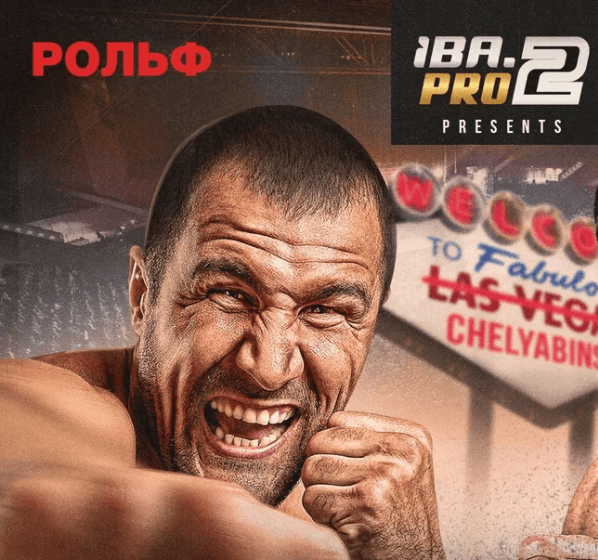
At his peak, former three-time world light heavyweight champion Sergey “Krusher” Kovalev ranked high on everyone’s pound-for-pound list. Now 42 years old – he turned 42 earlier this month – Kovalev has been largely inactive in recent years, but last night he returned to the ring in his hometown of Chelyabinsk, Russia, and rose to the occasion in what was billed as his farewell fight, stopping Artur Mann in the seventh frame.
Kovalev hit his peak during his first run as a world title-holder. He was 30-0-1 (26 KOs) entering first match with Andre Ward, a mark that included a 9-0 mark in world title fights. The only blemish on his record was a draw that could have been ruled a no-contest (journeyman Grover Young was unfit to continue after Kovalev knocked down in the second round what with was deemed an illegal rabbit punch). Among those nine wins were two stoppages of dangerous Haitian-Canadian campaigner Jean Pascal and a 12-round shutout over Bernard Hopkins.
Kovalev’s stature was not diminished by his loss to the undefeated Ward. All three judges had it 114-113, but the general feeling among the ringside press was that Sergey nicked it.
The rematch was also somewhat controversial. Referee Tony Weeks, who halted the match in the eighth stanza with Kovalev sitting on the lower strand of ropes, was accused of letting Ward get away with a series of low blows, including the first punch of a three-punch series of body shots that culminated in the stoppage. Sergey was wobbled by a punch to the head earlier in the round and was showing signs of fatigue, but he was still in the fight. Respected judge Steve Weisfeld had him up by three points through the completed rounds.
Sergey Kovalev was never the same after his second loss to Andre Ward, albeit he recaptured a piece of the 175-pound title twice, demolishing Vyacheslav Shabranskyy for the vacant WBO belt after Ward announced his retirement and then avenging a loss to Eleider Alvarez (TKO by 7) with a comprehensive win on points in their rematch.
Kovalev’s days as a title-holder ended on Nov. 2, 2019 when Canelo Alvarez, moving up two weight classes to pursue a title in a fourth weight division, stopped him in the 11th round, terminating what had been a relatively even fight with a hellacious left-right combination that left Krusher so discombobulated that a count was superfluous.
That fight went head-to-head with a UFC fight in New York City. DAZN, to their everlasting discredit, opted to delay the start of Canelo-Kovalev until the main event of the UFC fight was finished. The delay lasted more than an hour and Kovalev would say that he lost his psychological edge during the wait.
Kovalev had two fights in the cruiserweight class between his setback to Canelo and last night’s presumptive swan song. He outpointed Tervel Pulev in Los Angeles and lost a 10-round decision to unheralded Robin Sirwan Safar in Riyadh, Saudi Arabia.
Artur Mann, a former world title challenger – he was stopped in three rounds by Mairis Briedis in 2021 when Briedis was recognized as the top cruiserweight in the world – was unexceptional, but the 34-year-old German, born in Kazakhstan, wasn’t chopped liver either, and Kovalev’s stoppage of him will redound well to the Russian when he becomes eligible for the Boxing Hall of Fame.
Krusher almost ended the fight in the second round. He knocked Mann down hard with a short left hand and seemingly scored another knockdown before the round was over (but it was ruled a slip). Mann barely survived the round.
In the next round, a punch left Mann with a bad cut on his right eyelid, but the German came to fight and rounds three, four and five were competitive.
Kovalev had a good sixth round although there were indications that he was tiring. But in the seventh he got a second wind and unleashed a right-left combination that rolled back the clock to the days when he was one of the sport’s most feared punchers. Mann went down hard and as he staggered to his feet, his corner signaled that the fight should be stopped and the referee complied. The official time was 0:49 of round seven. It was the 30th KO for Kovalev who advanced his record to 36-5-1.
Addendum: History informs us that Farewell Fights have a habit of becoming redundant, by which we mean that boxers often get the itch to fight again after calling it quits. Have we seen the last of Sergey “Krusher” Kovalev? We woudn’t bet on it.
The complete Kovalev-Mann fight card was live-streamed on the Boxing News youtube channel.
To comment on this story in the Fight Forum CLICK HERE
-
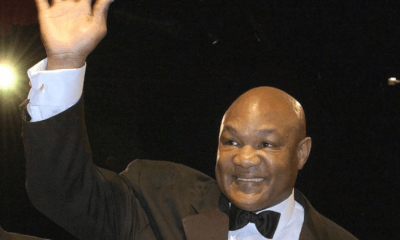
 Featured Articles4 weeks ago
Featured Articles4 weeks agoA Paean to George Foreman (1949-2025), Architect of an Amazing Second Act
-
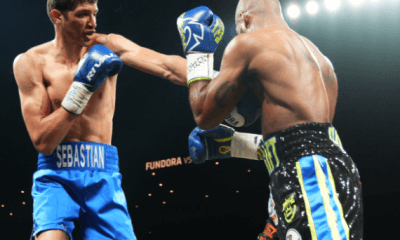
 Featured Articles4 weeks ago
Featured Articles4 weeks agoSebastian Fundora TKOs Chordale Booker in Las Vegas
-

 Featured Articles4 weeks ago
Featured Articles4 weeks agoBoxing Odds and Ends: The Wacky and Sad World of Livingstone Bramble and More
-
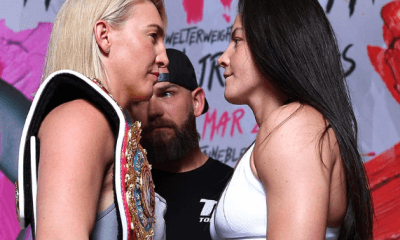
 Featured Articles3 weeks ago
Featured Articles3 weeks agoAvila Perspective, Chap. 319: Rematches in Las Vegas, Cancun and More
-

 Featured Articles3 weeks ago
Featured Articles3 weeks agoRingside at the Fontainebleau where Mikaela Mayer Won her Rematch with Sandy Ryan
-
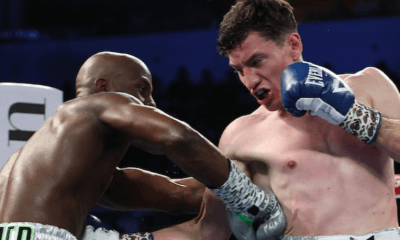
 Featured Articles3 weeks ago
Featured Articles3 weeks agoWilliam Zepeda Edges Past Tevin Farmer in Cancun; Improves to 34-0
-
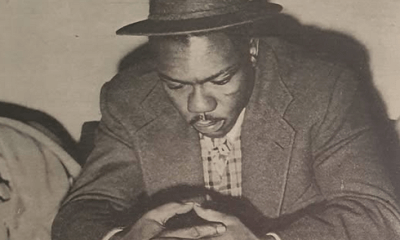
 Featured Articles3 weeks ago
Featured Articles3 weeks agoHistory has Shortchanged Freddie Dawson, One of the Best Boxers of his Era
-

 Featured Articles2 weeks ago
Featured Articles2 weeks agoAvila Perspective, Chap. 320: Women’s Boxing Hall of Fame, Heavyweights and More















